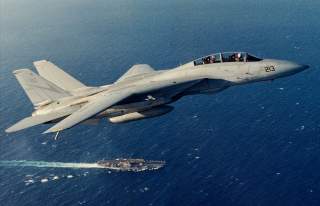What It's Like to Fly an F-14 Tomcat with Just One Engine
Yikes.
We descended to 600 feet and slowed to gear and flap speed about ten miles behind Ranger. As we approached the ship, the Air Boss gave us the signal that deck was ready and the LSO (landing safety officer) was standing by. He reminded us that in the case of a wave off or bolter I should get the gear up and get out of afterburner quickly. With just 400 pounds now indicated in my right feed tank, I too was concerned.
Aligning our flight path with that of the ship, we used ACLS needles to help us fly the approach to the ship like we did at night or in bad weather. To compensate for thrust asymmetry at this speed, I needed a considerable amount of rudder trim and our jet was cocked about 15 degrees to fly straight ahead. I was thankful for good visibility and daylight as the view of the ship out the left front windscreen instead of the front canopy bow would have been very disorienting at night. We had a very stable approach. I added a squirt more power as we encountered turbulence or the “burble” from the superstructure of the Ranger. The LSO said, “Don’t settle” and, “Just a little back off” as we crossed the ramp. I was concerned that our cocked attitude to the right would reduce the hook’s chance of engagement with the arresting wires so I eased out the rudder to align the fuselage with the center stripe of the landing area. At touch down, I added full power and reinstated the rudder correction as we came to a screeching halt on the angle deck. I never felt happier to be aboard an aircraft carrier in my life.
The ordeal had lasted 1.5 hours of flight time. After we shut our engine down and were chocked and tied down to the flight deck, we deplaned and were met by maintenance personnel and our Commanding Officer. He took me aside and with his arm around me asked if perhaps during the acceleration of the catapult stroke I had allowed the left engine throttle to roll back to idle, had become embarrassed and offered the engine failure as a cover story. I think he used my propensity to allow my RIO Bio to handle the radio transmissions throughout most of the event as a sign of weakness on my part. I learned to be more forceful on the radios after that even though the RIO has primary communications authority in the F-14.
After maintenance personnel spun up the engine to trouble-shoot, they quickly realized that something was very wrong. Without the mechanical load normally carried by the tower shaft, the engine spun well past its normal rpm almost immediately. The CO apologized to me, the LSO gave me the perfect landing grade of “OK – no comment,” and Bio and I were awarded the Commander Naval Air Forces Pacific Pros of the Week. I adopted the squadron training briefings on single engine and fuel system as my own as I continued my career in the F-14, thankful for daylight, good weather, and good luck that day off the coast of Vietnam in 1983.
A final note: In reviewing my logbook to prepare this article, I saw that my aircraft that day was 160888. Cross-referencing that to the aircraft in our squadron, I found that to be NG213, the aircraft with my name and Bio’s painted on the canopy rails!
I want to thank my former RIO, Dave “Bio” Baranek, for helping with this article. For more on the F-14 Tomcat, check out Bio’s website, www.topgunbio.com, and his book TOPGUN DAYS.
THE FACTS
– Date: Sep. 30, 1983
– Location: USS Ranger (CV-61), South China Sea
– Squadron: VF-24
– BuNo: 160888
– Modex: NG213
– Names: Pilot: LT STEVE PETROSKI, RIO: LT DAVE BARANEK
– Weapon Load: 1 x AIM-5A, 2 x AIM-7F, 2 x AIM-9L, 2 x External Tanks
This article by Steve Petro Petroski and Dave Bio Baranek originally appeared on The Aviation Geek Club in 2016.
Image: U.S. Navy

